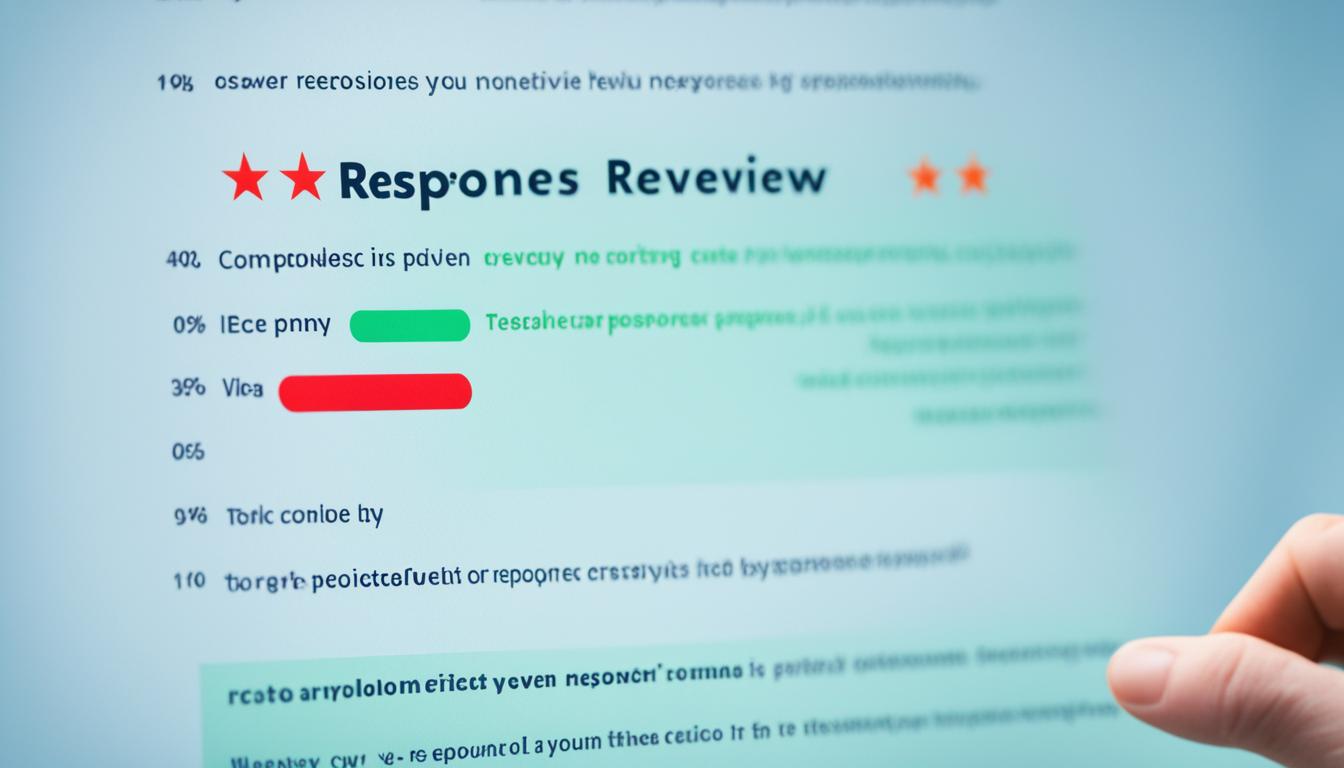Have you ever thought about how a single negative review could hurt your business? In today’s digital world, customer feedback is very powerful. A single bad review on Yelp can cause a $180,000 loss for a $2 million restaurant1. This shows how important it is for businesses to have strong plans for dealing with negative reviews.
Nowadays, 94% of people check online reviews before picking a place to eat1. This isn’t just for restaurants; it affects all kinds of businesses. Handling negative reviews well is key to keeping a good online image and growing your business.
When businesses talk to customers who leave negative reviews, they show they care. In fact, 44.6% of people might visit a business more if the owner talks back to online complaints1. This fact shows how crucial it is to have a plan for dealing with customer feedback.
Having good plans for dealing with negative reviews means your team can handle feedback quickly and well. This not only solves customer problems but can also make customers more loyal, by 16%2. But ignoring these reviews can lead to a 37% drop in customer loyalty2.
We’ll look at the main parts of setting up plans for dealing with negative reviews. We’ll talk about why it’s important to answer negative feedback, building a team for review responses, and how to write responses that turn unhappy customers into fans.
Key Takeaways
- Negative reviews can really hurt a business’s money and image
- Talking to negative reviews builds trust and makes people more likely to visit
- Having a plan for dealing with reviews is key for good customer service
- Answering feedback can make customers more loyal
- Ignoring feedback can lead to a big drop in customer support
- A good plan for feedback can turn critics into loyal customers
The Importance of Addressing Negative Reviews
Handling negative reviews is key in today’s digital world. Customer feedback greatly affects a brand’s reputation. In fact, 94% of consumers have avoided a business because of a bad review3. This shows how big of an impact negative reviews can have on customers and a business’s success.
It’s important to quickly answer to negative reviews to keep customers happy. A big 53% of customers want a response within a week, but 63% never hear back3. This shows a chance for businesses to shine by really listening to what customers say.
Answering to negative reviews can make customers see you in a better light. In fact, 45% of consumers might visit a business that talks back to negative reviews3. By fixing issues and showing you care, businesses can turn bad situations into chances to grow and get better.
Managing reviews well is more than fixing problems. It shows your business cares about serving customers and handling criticism well. When answering, focus on:
- Talking to reviewers directly
- Saying thanks for their feedback
- Offering real apologies when needed
- Taking blame for mistakes
- Showing how to fix issues
By doing these things, businesses can make their reputation better and build stronger bonds with customers. Remember, every review is a chance to show you’re all about making customers happy and always getting better.
Creating an Effective Internal Review Response Team

Having a formal review response team helps us deal with customer feedback better. We train our team in customer service and communication skills. This makes them do their jobs well. A good response plan means we can handle incidents quickly and avoid bigger problems later4.
To make a strong review response team, we focus on these key areas:
- Selecting team members with excellent listening skills
- Training in professional communication techniques
- Developing objective feedback analysis abilities
- Implementing regular review site checks
Our plan for handling incidents has four steps: preparation, detection and analysis, containment and recovery, and post-incident review5. This keeps our online reputation strong.
| Skill | Importance | Training Focus |
|---|---|---|
| Active Listening | High | Understanding customer concerns |
| Calm Under Pressure | Critical | Stress management techniques |
| Professional Writing | Essential | Crafting clear, empathetic responses |
| Feedback Analysis | Important | Identifying trends and improvement areas |
Having a team with different skills helps us tackle problems, fix systems, and lower risks6. By training our team well and using clear communication, we make sure they can quickly and effectively address customer concerns.
Developing Internal Review Response Protocols

We’ve made a detailed set of review response guidelines. They help us talk to our customers in a consistent and timely way. Our rules focus on six key areas: saying hello personally, pointing out the good stuff, saying sorry for problems, explaining how to fix them, moving talks offline, and asking customers to come back. These rules keep us professional and show we care about serving our customers well.
We set clear times to answer reviews to keep things organized. For detailed reviews, we try to reply in 4-8 weeks, and quicker ones in 2-4 weeks. Reviews that need less work get looked at in less than a week7. This way, we can handle our work well and focus on what’s important.
When things get tough, we have a plan for that too. We have a special team for reviews that need a lot of work. This is very important for reviews about sensitive topics or risky situations7.
Keeping an eye on review sites and social media is a big part of our plan. We use special tools to find new reviews and mentions quickly. This helps us answer fast and keep a good image online. By following these rules, we make sure to give great customer service and build strong relationships with our audience.
Best Practices for Crafting Review Responses

Writing good review responses is key to keeping a positive brand image. It’s important to make your responses personal, addressing specific issues mentioned in the review. This shows you care about their feedback and want to fix their problems8.
Always thank customers for their business and use their name if you can. This makes them feel valued and more likely to come back. Start by mentioning the good parts of their experience before talking about any issues98.
When dealing with negative reviews, saying sorry is a must. Apologize for any problems and explain what you’re doing to stop them in the future. This shows you’re serious about making things better and might even change a negative review into a positive one10.
Our way of solving problems is to give contact info for a specific person to talk more privately. This way, you can solve the issue in a more personal way. It shows you’re willing to do more to fix customer issues8.
Getting customers back on your side is crucial. Consider offering a discount on their next visit to show you care. This can turn a unhappy customer into a loyal one9.
See reviews as chances to get better at what you do. By following these tips, you can handle your online reputation well and build stronger bonds with your customers.
Conclusion
We’ve looked at how a strong review response strategy is key to boosting customer happiness and handling online reputation. Having a team ready and clear rules helps turn bad feedback into chances for growth. This way, companies can fix issues fast and show they care about doing well for customers.
Managing reviews well is more than just answering back. It’s about having a system that always gives quick, professional, and caring replies. This is like how important clear goals and steps are in research11. Businesses that are good at handling reviews often build better customer relationships and gain more trust12.
Using the best ways to handle reviews is like sticking to research ethics. Both need careful thought, being open, and focusing on what the user needs1113. By doing this, companies can grow over time and keep a good online image. Remember, every review is a chance to show you’re serious about making customers happy and always getting better.
FAQ
Why is addressing negative reviews important?
How quickly should businesses respond to negative reviews?
What are the key elements of an effective review response?
How can businesses ensure consistent and professional review responses?
What should be avoided when responding to negative reviews?
How can responding to negative reviews benefit a business?
Source Links
- The Right Way To Respond To Bad Restaurant Reviews – https://www.lightspeedhq.com/blog/bad-restaurant-reviews/
- How to Respond to Negative Reviews Online – Brightlocal – https://www.brightlocal.com/learn/review-management/profile-management/how-to-respond-to-negative-reviews/
- Powerful Examples of How to Respond to Negative Reviews – https://www.reviewtrackers.com/guides/examples-responding-reviews/
- Incident Response Plan: How to Build, Examples, Template – https://www.techtarget.com/searchsecurity/feature/5-critical-steps-to-creating-an-effective-incident-response-plan
- NIST Incident Response Plan: Building Your IR Process – https://www.cynet.com/incident-response/nist-incident-response/
- Developing your incident response plan (ITSAP.40.003) – Canadian Centre for Cyber Security – https://www.cyber.gc.ca/en/guidance/developing-your-incident-response-plan-itsap40003
- IRB Review Process | Research Ethics & Compliance – https://research-compliance.umich.edu/human-subjects/irb-health-sciences-and-behavioral-sciences-hsbs/irb-review-process
- 15 Positive Reviews Response Examples to Use in 2024 – LiveChatAI.com – https://livechatai.com/blog/positive-reviews-response-examples
- Positive review responses: Examples and best practices – https://appbot.co/blog/positive-review-response-examples/
- The Best List of Positive Review Response Examples – https://usersnap.com/blog/positive-review-response-examples/
- Front matter source.pdf – https://icahn.mssm.edu/files/ISMMS/Assets/Research/IHCDS/Guidelines for Writing the research protocol by WHO.pdf
- Chapter 9 Methods for Literature Reviews – Handbook of eHealth Evaluation: An Evidence-based Approach – https://www.ncbi.nlm.nih.gov/books/NBK481583/
- PLOS ONE – https://journals.plos.org/plosone/s/reviewer-guidelines

